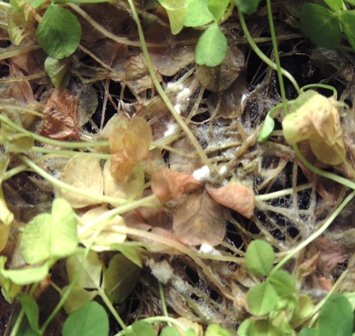Sclerotinia rot
Sclerotinia rot is caused by the fungus Sclerotinia trifoliorum. It usually occurs in late autumn and winter, particularly on pure swards of clover. Generally it is not serious.
Identification
Leaves or petioles become flaccid and light brown. Disease spreads by white mycelium through into surrounding plants. Patches of clover can rot, causing a light brown slimy mass of decaying vegetation. Tufts of white fungus develop on affected tissue. These eventually turn into black bodies called sclerotia.
Spread
Sclerotia remain in the soil for several months.
Under moist conditions they germinate to produce small, fruiting bodies which eject spores into the air, spreading the infection. These require dead tissue to become established. The growing fungus produces phytotoxic enzymes that rot the host tissue.
Prevention and management
Graze at the right time to prevent clover becoming rank and wet. Fungicides are not economic.

Sclerotinia rot on clover.

